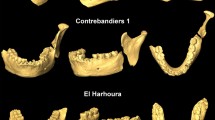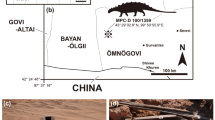Abstract
The Plio-Pleistocene site of Dmanisi, Georgia, has yielded a rich fossil and archaeological record documenting an early presence of the genus Homo outside Africa. Although the craniomandibular morphology of early Homo is well known as a result of finds from Dmanisi and African localities, data about its postcranial morphology are still relatively scarce. Here we describe newly excavated postcranial material from Dmanisi comprising a partial skeleton of an adolescent individual, associated with skull D2700/D2735, and the remains from three adult individuals. This material shows that the postcranial anatomy of the Dmanisi hominins has a surprising mosaic of primitive and derived features. The primitive features include a small body size, a low encephalization quotient and absence of humeral torsion; the derived features include modern-human-like body proportions and lower limb morphology indicative of the capability for long-distance travel. Thus, the earliest known hominins to have lived outside of Africa in the temperate zones of Eurasia did not yet display the full set of derived skeletal features.
This is a preview of subscription content, access via your institution
Access options
Subscribe to this journal
Receive 51 print issues and online access
$199.00 per year
only $3.90 per issue
Buy this article
- Purchase on Springer Link
- Instant access to full article PDF
Prices may be subject to local taxes which are calculated during checkout



Similar content being viewed by others
References
Gabunia, L. & Vekua, A. A. Plio-Pleistocene hominid from Dmanisi, East Georgia, Caucasus. Nature 373, 509–512 (1995)
Gabunia, L. et al. Earliest Pleistocene hominid cranial remains from Dmanisi, Republic of Georgia: Taxonomy, geological setting, and age. Science 288, 1019–1025 (2000)
Vekua, A. et al. A new skull of early Homo from Dmanisi, Georgia. Science 297, 85–89 (2002)
Gabunia, L., de Lumley, M.-A., Vekua, A., Lordkipanidze, D. & de Lumley, H. Découverte d’un nouvel hominidé à Dmanissi (Transcaucasie, Géorgie). C.R. Palévol. 1, 243–253 (2002)
Lordkipanidze, D. et al. The earliest toothless hominin skull. Nature 434, 717–718 (2005)
Rightmire, G. P., Lordkipanidze, D. & Vekua, A. Anatomical descriptions, comparative studies and evolutionary significance of the hominin skulls from Dmanisi, Republic of Georgia. J. Hum. Evol. 50, 115–141 (2006)
Lordkipanidze, D. et al. A fourth hominin skull from Dmanisi, Georgia. Anat. Rec. 288A, 1146–1157 (2006)
Walker, A. & Leakey, R. The Nariokotome Homo erectus Skeleton (Springer, Berlin, 1993)
Brown, P. et al. A new small-bodied hominin from the Late Pleistocene of Flores, Indonesia. Nature 431, 1055–1061 (2004)
Gabunia, L., Vekua, A. & Lordkipanidze, D. The environmental contexts of early human occupation of Georgia (Transcaucasia). J. Hum. Evol. 38, 785–802 (2000)
Tappen, M., Ferring, R., Lordkipanidze, D., Vekua, A. & Kiladze, G. in Current Topics on Taphonomy and Fossilization (eds de Renzi, M. et al.) 161–170 (Ajuntament de Valencia, Valencia, 2002)
Vrba, E. S. A new study of the scapula of Australopithecus africanus from Sterkfontein. Am. J. Phys. Anthropol. 51, 117–129 (1979)
Johanson, D. C. C. et al. Morphology of the Pliocene partial hominid skeleton (A.L. 288–1) from the Hadar formation, Ethiopia. Am. J. Phys. Anthropol. 57, 403–451 (1982)
Jashashvili, T. Hominid Upper Limb Remains from the Paleolithic Site of Dmanisi. PhD thesis, Georgian National Museum and Univ. Ferrara. (2005)
Weidenreich, F. Discovery of the femur and the humerus of Sinanthropus pekinensis. Nature 141, 614–617 (1938)
Day, M. H. in Early Hominids of Africa (eds Jolly, C. J.) 311–345 (St Martin’s Press, New York, 1978)
Senut, B. L'humérus et ses articulations chez les Hominidés plio-pléistocènes (CNRS, Paris, 1981)
Larson, S. G. Estimating humeral torsion on incomplete fossil anthropoid humeri. J. Hum. Evol. 31, 239–257 (1996)
Morwood, M. J. et al. Further evidence for small-bodied hominins from the Late Pleistocene of Flores, Indonesia. Nature 437, 1012–1017 (2005)
Day, M. H., Leakey R. E. F, Walker A. C & Wood, B. A. New hominids from East Rudolf, Kenya, I. Am. J. Phys. Anthropol. 42, 461–475 (1975)
Kennedy, G. E. A morphometric and taxonomic assessment of a hominine femur from the lower member, Koobi Fora, Lake Turkana. Am. J. Phys. Anthropol. 61, 429–436 (1983)
Lovejoy, C. O., Meindl, R. S., Ohman, J. C., Heiple, K. G. & White, D. T. The Maka femur and its bearing on the antiquity of human walking: Applying contemporary concepts of morphogenesis to the human fossil record. Am. J. Phys. Anthropol. 119, 97–133 (2002)
Tardieu, C. & Trinkaus, E. Early ontogeny of the human femoral bicondylar angle. Am. J. Phys. Anthropol. 95, 183–195 (1994)
Susman, R. L. New hominid fossils from the Swartkrans formation (1979–1986 excavations): postcranial specimens. Am. J. Phys. Anthropol. 79, 451–474 (1989)
Leakey, R. E. F. & Walker, A. C. New australopithecines from East Rudolf, Kenya (III). Am. J. Phys. Anthropol. 39, 205–221 (1973)
Day, M. H. & Leakey, R. E. F. New evidence of the genus Homo from East Rudolf, Kenya (III). Am. J. Phys. Anthropol. 41, 367–380 (1974)
Rhoads, J. G. & Trinkaus, E. Morphometrics of the Neandertal talus. Am. J. Phys. Anthropol. 46, 29–43 (1977)
Aiello, L. & Dean, C. An Introduction to Human Evolutionary Anatomy (Academic, London, 1990)
Susman, R. L. & de Ruiter, D. J. New hominin first metatarsal (SK 1813) from Swartkrans. J. Hum. Evol. 47, 171–181 (2004)
Susman, R. L. & Stern, J. T. Functional morphology of Homo habilis. Science 217, 931–934 (1982)
Johanson, D. C. & Taieb, M. Plio-Pleistocene hominid discoveries in Hadar, Ethiopia. Nature 260, 293–297 (1976)
Leakey, L. S. B., Tobias, P. V. & Napier, J. R. A new species of the genus Homo from Olduvai Gorge. Curr. Anthropol. 6, 424–427 (1964)
Susman, R. L. & Creel, N. Functional and morphological affinities of the subadult hand (O.H. 7) from Olduvai Gorge. Am. J. Phys. Anthropol. 51, 311–332 (1979)
Johanson, D. C. et al. New partial skeleton of Homo habilis from Olduavi Gorge, Tanzania. Nature 327, 205–209 (1987)
Leakey, R. E. F., Walker, A., Ward, C. V. & Grausz, H. M. in Hominidae (eds Giacobini, G.) 167–173 (Jaka Books, Milan, 1989)
Feibel, C. S., Brown, F. H. & McDougall, I. Stratigraphic context of fossil hominids from the Omo group deposits: Northern Turkana Basin, Kenya and Ethiopia. Am. J. Phys. Anthropol. 78, 595–622 (1989)
White, T. D. in Encyclopedia of Human Evolution and Prehistory (eds Delson, E., Tattersall, I., Van Couvering, J. A. & Brook, A. L.) 486–489 (Garland Publishing, New York, 2000)
Haeusler, M. & McHenry, H. M. Body proportions of Homo habilis reviewed. J. Hum. Evol. 46, 433–465 (2004)
Richmond, B. G., Aiello, L. & Wood, B. Early hominin limb proportions. J. Hum. Evol. 43, 529–548 (2002)
Green, D. J., Gordon, A. D. & Richmond, B. G. Limb-size proportions in Australopithecus afarensis and Australopithecus africanus. J. Hum. Evol. 52, 187–200 (2007)
McHenry, H. M. Body size and proportions in early hominids. Am. J. Phys. Anthropol. 87, 407–431 (1992)
Ruff, C. Body size prediction from juvenile skeletal remains. Am. J. Phys. Anthropol. 133, 698–716 (2007)
Asfaw, B. et al. Remains of Homo erectus from Bouri, Middle Awash, Ethiopia. Nature 416, 317–320 (2002)
Pontzer, H. Predicting the energy cost of terrestrial locomotion: a test of the limb model in humans and quadrupeds. J. Exp. Biol. 210, 484–494 (2007)
Elton, S., Bishop, L. C. & Wood, B. Comparative context of Plio-Pleistocene hominin brain evolution. J. Hum. Evol. 41, 1–27 (2001)
Rightmire, G. P. Brain size and encephalization in early to Mid-Pleistocene Homo. Am. J. Phys. Anthropol. 124, 109–123 (2004)
Bramble, D. M. & Lieberman, D. E. Endurance running and the evolution of Homo. Nature 432, 345–352 (2004)
Reagan, K. M. et al. Humeral retroversion and its relationship to glenohumeral rotation in the shoulder of college baseball players. Am. J. Sports Med. 30, 354–360 (2002)
Stern, J. T. & Susman, R. L. The locomotor anatomy of Australopithecus afarensis. Am. J. Phys. Anthropol. 60, 279–317 (1983)
McHenry, H. M. How big were early hominids? Evol. Anthropol. 1, 15–20 (1992)
Acknowledgements
We acknowledge H. Herrmer for identification of cheetah remains from Dmanisi; M. Delfino for providing a revision of the amphibian and reptilian fauna; E. Trinkaus and M. Häusler for comments; G. Bumbiashvili and N. Andriashvili for the photographs; and the excavation team for constant support. Palaeomagnetic measurements were carried out at the SCT of the Barcelona University. This work was supported by a grant of the Georgian National Science Foundation, a Rolex award for enterprise, BP Georgia, the National Geographic Society, a Dan David 2003 scholarship, the Swiss National Science Foundation, the Strategic Research Funds of the University of Zurich, Wenner-Gren Foundation short-term fellowships, the Fundación Duques de Soria, a CNRS international research project grant, ECO-NET (a joint international project of the French Ministry of Foreign Affairs between France, Georgia and Azerbaijan), The Italian Ministry for Foreign Affairs (DGPCC-V), the Spanish Ministry of Education and Science, the Consejeria de Cultura de Andalucia, The National Science Foundation (USA) and the L. S. B. Leakey Foundation.
Author Contributions D.L. directs and coordinates research at Dmanisi; T.J, M.S.P.de L. and C.P.E.Z. performed comparative morphological/morphometric analyses, designed the paper and wrote the main text; G.P.R. and H.P. contributed to comparative descriptions; R.F. performed stratigraphical analyses; O.O. performed palaeomagnetic analyses; M.T. performed taphonomic analyses; G.K. organized fieldwork and prepared specimens; and A.V., M.B., J.A., R.K., B.M.-N., A.M., M.N. and L.R. performed fieldwork and provided comparative faunal analyses.
Author information
Authors and Affiliations
Corresponding author
Ethics declarations
Competing interests
Reprints and permissions information is available at www.nature.com/reprints. The authors declare no competing financial interests.
Supplementary information
Supplementary Information
The file contains Supplementary Notes, Supplementary Figures S1-S5 with Legends, Supplementary Tables S1-S8 and additional references. (PDF 2582 kb)
Rights and permissions
About this article
Cite this article
Lordkipanidze, D., Jashashvili, T., Vekua, A. et al. Postcranial evidence from early Homo from Dmanisi, Georgia. Nature 449, 305–310 (2007). https://doi.org/10.1038/nature06134
Received:
Accepted:
Issue Date:
DOI: https://doi.org/10.1038/nature06134
This article is cited by
-
The earliest Ethiopian wolf: implications for the species evolution and its future survival
Communications Biology (2023)
-
Déjà vu: on the use of meat resources by sabretooth cats, hominins, and hyaenas in the Early Pleistocene site of Fuente Nueva 3 (Guadix-Baza Depression, SE Spain)
Archaeological and Anthropological Sciences (2023)
-
The earliest Pleistocene record of a large-bodied hominin from the Levant supports two out-of-Africa dispersal events
Scientific Reports (2022)
-
Variation in human 3D trunk shape and its functional implications in hominin evolution
Scientific Reports (2022)
Comments
By submitting a comment you agree to abide by our Terms and Community Guidelines. If you find something abusive or that does not comply with our terms or guidelines please flag it as inappropriate.



